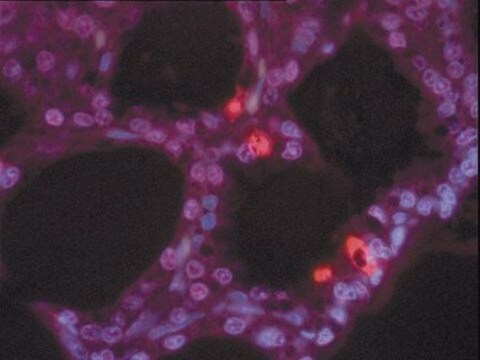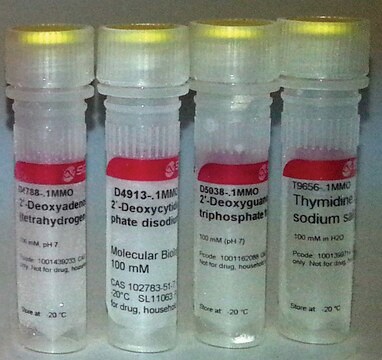RTT-RO
Roche
Terminal Transferase
from Calf Thymus, recombinant, E. coli
About This Item
Prodotti consigliati
Ricombinante
expressed in E. coli
Livello qualitativo
Forma fisica
solution
impiego
sufficient for 20 reactions (03333566001)
sufficient for 60 reactions (03333574001)
Confezionamento
pkg of 24,000 U (03333574001 [400 U per reaction])
pkg of 8,000 U (03333566001 [400 U per reaction])
Produttore/marchio commerciale
Roche
applicazioni
genomic analysis
Temperatura di conservazione
−20°C
Descrizione generale
Applicazioni
- Tailing with dNTPs:Addition of homopolymeric tails to DNA fragments
- Labeling of double- and single-stranded DNA and oligonucleotides with either radioactive or chemically modified nucleotides (e.g., DIG-dUTP)
Labeling of double- and single-stranded DNA and oligonucleotides with either radioactive or chemically modified dideoxynucleotides (e.g., DIG-ddUTP)
Caratteristiche e vantaggi
In addition to standard nucleotides, terminal transferase wlll add radioactive or modified (e.g., digoxigenin-, biotin-, or fluorochrome-labeled) dNTPs or ddNTPs to DNA.
Confezionamento
Qualità
Principio
Definizione di unità
Unit Assay: Unit assay conditions: 200 mM Potassium cacodylate, 1 mM CoCl2, 1 mM dTTP, 0.1 OD d(pT)6, 6.25 pmol 3H dTTP in a 120 μl reaction volume.
Volume Activity: 400 U/μl
Sample Materials
- Double- or single-stranded DNA fragments
- Double- or single-stranded oligonucleotides
Nota sulla preparazione
Preparation of CoCl2 working solution
Add in a sterile vial 10 μl double dist. water and 15 μl of the supplied 25 mM CoCl2 solution: Final concentration: 15 mM
Preparation of radioactive labeling mix
dATP and dTTP labeling mix: mix 1 Vol. of a 2.5 mM dATP or dTTP solution with 15 volumes of double-distilled water and 4 volumes of α-32P-dATP or α-32P-dTTP (800 Ci/mmol, approx. 30 TBq/mmol).
dGTP and dCTP labeling mix: mix 1 volume of a 2 mM dGTP or dCTP solution with 15 volumes of double-distilled water and 4 volumes of α-32P-dGTP or α-32P-dCTP (800 Ci/mmol, approx. 30 TBq/mmol)
Altre note
Solo come componenti del kit
- Terminal Transferase 400 U/μl
- TdT Reaction Buffer 5x concentrated
- CoCl<sub>2</sub> Solution 25 mM
Avvertenze
Danger
Indicazioni di pericolo
Consigli di prudenza
Classi di pericolo
Acute Tox. 4 Inhalation - Acute Tox. 4 Oral - Aquatic Chronic 2 - Carc. 1B Inhalation - Repr. 1B
Codice della classe di stoccaggio
6.1D - Non-combustible, acute toxic Cat.3 / toxic hazardous materials or hazardous materials causing chronic effects
Classe di pericolosità dell'acqua (WGK)
WGK 3
Punto d’infiammabilità (°F)
does not flash
Punto d’infiammabilità (°C)
does not flash
Certificati d'analisi (COA)
Cerca il Certificati d'analisi (COA) digitando il numero di lotto/batch corrispondente. I numeri di lotto o di batch sono stampati sull'etichetta dei prodotti dopo la parola ‘Lotto’ o ‘Batch’.
Possiedi già questo prodotto?
I documenti relativi ai prodotti acquistati recentemente sono disponibili nell’Archivio dei documenti.
I clienti hanno visto anche
Il team dei nostri ricercatori vanta grande esperienza in tutte le aree della ricerca quali Life Science, scienza dei materiali, sintesi chimica, cromatografia, discipline analitiche, ecc..
Contatta l'Assistenza Tecnica.














